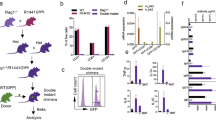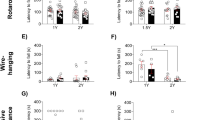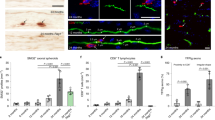Abstract
Mutations in the presenilin-1 (PS1) gene are causally linked to early-onset Alzheimer’s disease (AD). Studies of neurons suggest that PS1 mutations result in a gain-of-function, which perturbs calcium regulation and increases cell vulnerability to apoptosis. Alterations in immune cell function have also been demonstrated in AD, and a role for PS1 in immune regulation has been suggested recently. We now report that splenocytes from PS1-mutant (M146V) knockin mice exhibit increased caspase activity, abnormal calcium regulation and aberrant mitochondrial function. Isolated splenic T cells from PS1-mutant mice respond poorly to proliferative signals and have downregulated cluster designation 3 and interleukin (IL)-2-receptor expression necessary for a normal T-cell immune response. Thus, adverse effects of a mutation that causes AD on immune function that involves perturbed calcium regulation and cytokine signaling in lymphocytes, and associated sensitivity of lymphocytes to apoptosis are demonstrated. These findings suggest that abnormalities in immune function might play major roles in the pathogenesis of AD.
Similar content being viewed by others
References
Araujo D. M. and Lapchak P. A. (1994) Induction of immune system mediators in the hippocampal formation in Alzheimer’s and Parkinson’s diseases: selective effects on specific interleukins and interleukin receptors. Neurosci. 61, 745–754.
Baki L., Marambaud P., Ethimiopoulos S., et al. (2001) Presenilin-1 binds cytoplasmic epithelial cadherin, inhibits cadherin/p120 association, and regulates stability and function of the cadherin/catenin adhesion complex. Proc. Natl. Acad. Sci. USA 98, 2381–2386.
Begley J. G., Duan W., Chan S., Duff K., and Mattson M. P. (1999) Altered calcium homeostasis and mitochondrial dysfunction in cortical synaptic compartments of presenilin-1 mutant mice. J. Neurochem. 72, 1030–1039.
Berridge M. J., Lipp P., and Bootman M. D. (2000) The versatility and universality of calcium signaling. Nat. Rev. Mol. Cell Biol. 1, 11–21.
Brunkan A. L. and Goate A. M. (2005) Presenilin function and gamma-secretase activity. J. Neurochem. 93, 769–792.
Buxbaum J. D., Choi E. K., Luo Y., et al. (1998) Calsenilin: a calcium-binding protein that interacts with the presenilins and regulates the levels of presenilin fragment. Nat. Med. 4, 1177–1181.
Chan S. L., Mayne M., Holden C. P., Geiger J. D., and Mattson M. P. (2000) Presenilin-1 mutations increase levels of ryanodine receptors and calcium release in PC12 cells and cortical neurons. J. Biol. Chem. 275, 18,195–18,200.
Chan S. L., Griffin W. S., and Mattson M. P. (1999) Evidence for caspase-mediated cleavage of AMPA receptor subunits in neuronal apoptosis and Alzheimer’s disease. J. Neurosci. Res. 57, 315–323.
Curtin J. F., Donovan M., and Cotter T. G. (2002) Regulation and measurement of oxidative stress in apoptosis. J. Immunol. Methods 265, 49–72.
DeStrooper B., Saftig P., Crassaerts K., et al. (1998) Deficiency of presenilin-1 inhibits the normal cleavage of amyloid precursor protein. Nature 291, 387–390.
Duan W., Zhang Z., Gash D. M., and Mattson M. P. (1999) Participation of prostate apoptosis response-4 in degeneration of dopaminergic neurons in models of Parkinson’s disease. Ann. Neurol. 46, 587–597.
Duff K., Eckman C., Zehr C., et al. (1996) Increased amyloid-beta 42(43) in brains of mice expressing mutant presenilin 1. Nature 383, 710–713.
Eckert A., Cotman C. W., Zerfass R., Hennerici M., and Muller W. E. (1998) Lymphocytes as cell model to study apoptosis in Alzheimer’s disease: vulnerability to programmed cell death appears to be altered. J. Neural Transm. Suppl. 54, 259–267.
Eckert A., Schindowski K., Leutner S., et al. (2001) Alzheimer’s disease-like alterations in peripheral cells from presenilin-1 transgenic mice. Neurobiol. Dis. 8, 331–342.
Fraser P. E., Yu G., Levesque L., et al. (2001) Presenilin function: connections to Alzheimer’s disease and signal transduction. Biochem. Soc. Symp. 67, 89–100.
Grossmann A., Kukull W. A., Jinneman J. C., et al. (1993) Intracellular calcium response is reduced in CD4+ lymphocytes in Alzheimer’s disease and in older persons with Down’s syndrome. Neurobiol. Aging 14, 177–185.
Guo Q., Fu W., Sopher B. L. et al. (1999) Increased vulnerability of hippocampal neurons to excitotoxic necrosis in presenilin-1 mutant knock-in mice. Nature Medicine 5, 101–106.
Guo Q., Fu W., Xie J., et al. (1998) Par-4 is a mediator of neuronal degeneration associated with the pathogenesis of Alzheimer disease. Nature Med. 4, 957.
Guo Q., Sebastian L., Sopher B. L., et al. (1999) Increased vulnerability of hippocampal neurons from presenilin-1 mutant knock-in mice to amyloid betapeptide toxicity: central roles of superoxide production and caspase activation. J. Neurochem. 72, 1019–1029.
Hardy J. (1997) Amyloid, the presenilins and Alzheimer’s disease. Trends Neurosci. 20, 154.
Jehn B. M., Bielke W., Pear W. S., and Osborne B. A. (1999) Cutting edge: protective effects of Notch-1 on TCR-induced apoptosis. J. Immunol. 162, 635.
Leissring M. A., LaFerla F. M., Callamaras N., and Parker I. (2001) Subcellular mechanisms of presenilin-mediated enhancement of calcium signaling. Neurobiol. Dis. 8, 469–478.
Lombardi V. R., Garcia M., Rey L., and Cacabelos R. (1999) Characterization of cytokine production, screening of lymphocyte subset patterns and in vitro apoptosis in healthy and Alzheimer’s disease (AD) individuals. J. Neuroimmunol. 97, 163–171.
Maillard I., Adler S. H., and Pear W. S. (2003) Notch and the immune system. Immunity 19, 781–791.
Mattson M. P. (1997) Cellular actions of β-amyloid precursor protein and its soluble and fibrillogenic derivatives. Physiol. Rev. 77, 1081–1132.
Mattson M. P. and Chan S. C. (2003) Nat. Cell Biol. 5, 1041–1043.
Mattson M. P., Zhang Y., and Bose S. (1993) Growth factors prevent mitochondrial dysfunction, loss of calcium homeostasis, and cell injury, but not ATP depletion in hippocampal neurons deprived of glucose. Exp. Neurol. 121, 1–13.
Mattson M. P., Lovell M. A., Furukawa K., and Markesbery W. R. (1995) Neurotrophic factors attenuate glutamate-induced accumulation of peroxides, elevation of intracellular Ca2+ concentration, and neurotoxicity and increase antioxidant enzyme activities in hippocampal neurons. J. Neurochem. 65, 1740–1751.
Mattson M. P., Goodman Y., Lou H., Fu W., and Furukawa K. (1997) Activation of NF-Kappa β protects hippocampal neurons against oxidative stress-induced apoptosis: evidence for induction of manganese superoxide dismutase and suppression of peroxynitrite production and protein tyrosine nitration. J. Neurosci. Res. 49, 681–691.
Morgan G., Smith S., Pak J., Marshak-Rothstein A., Fissore R., and Osborne B. A. (1999) Characterization of a mutant T-cell hybridoma line with defects in the TCR-mediated apoptotic pathway. Cell Death Diff. 6, 36–47.
Newmeyer D. D. and Ferguson-Miller S. (2003) Mitochondria: releasing power for life and unleashing the machineries of death. Cell 112, 480–490.
Pereira C., Agostinho P., Moreira P. L., Cardoso S. M., and Oliveira C. R. (2005) Alzheimer’s disease-associated neurotoxic mechanisms and neuroprotective strategies. Curr. Drug Targets CNS Neurol. Disord. 4(4), 383–403.
Popovic M., Caballero-Bleda M., Puelles L., and Popovic N. (1998) Importance of immunological and inflammatory processes in the pathogenesis and therapy of Alzheimer’s disease. Int. J. Neurosci. 95, 203–236.
Qyang Y., Chambers S. M., Wang P., et al. (2004) Myeloproliferative disease in mice with reduced presenilin gene dosage: effect of gamma-secretase blockage. Biochemistry 43, 5352–5359.
Selkoe D. J. (2002) Alzheimer’s disease: genes, proteins, and therapy, Physiol. Rev. 81, 741–766.
Shalit K., Sredni B., Brodie C., Kott E., and Huberman M. (1995) T lymphocytes subpopulations and activation markers correlate with severity of Alzheimer’s disease. Clin. Immunol. Immunopathol. 75, 246–250.
Sherrington R., Rogaev E. I., Liang Y., et al. (1995) Cloning of a gene bearing missense mutations in early-onset familial Alzheimer’s disease. Nature 375, 754–760.
Stieler J. T., Lederer C., Bruckner M. K., Wolf H., Holzer M., and Gertz H. J. (2001) Impairment of mitogenic activation of peripheral blood lymphocytes in Alzheimer’s disease. Neuroreport 12(18), 3969–3972.
Sulger J., Dumais-Huber C., Zerfass R., Henn F. A., and Aldenhoff J. B. (1999) The calcium response of human T lymphocytes is decreased in aging but increased in Alzheimer’s dementia. Biol. Psychiatr. 45, 737–742.
Tanzi R. E., Kovacs D. M., Kim T. W., Moir R. D., Guenette S. Y., and Wasco W. (1996) The gene defects responsible for familial Alzheimer’s disease. Neurobiol. Dis. 3, 159–168.
Tournoy J., Bossuyt X., Snellinx A., et al. (2004) Partial loss of presenilins causes seborrheic keratosis and autoimmune disease in mice. Hum. Mol. Genet. 13, 1321–1331.
Weidemann A., Eggert S., Reinhard F. B., et al. (2002) A novel epsilon-cleavage within the transmembrane domain of the Alzheimer amyloid precursor protein demonstrates homology with Notch processing. Biochemistry 41, 2825–2835.
Author information
Authors and Affiliations
Corresponding author
Rights and permissions
About this article
Cite this article
Morgan, G.A., Guo, Q., Chan, S.L. et al. Defects of immune regulation in the presenilin-1 mutant knockin mouse. Neuromol Med 9, 35–45 (2007). https://doi.org/10.1385/NMM:9:1:35
Received:
Revised:
Accepted:
Issue Date:
DOI: https://doi.org/10.1385/NMM:9:1:35




